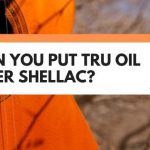Shellac is pretty versatile stuff. Used in a wide range of resin-based coatings, this substance can be found in everything from furniture to confectionery.
As a food additive, it is non toxic, and gives sweets that mouthwatering gleam. And that same gleam is also why shellac is used as a glossy wood finish.
But, shellac has a bit of a reputation for having adhesion problems. And top coating this natural substance isn’t always the easiest thing. Sometimes, getting anything to stick to shellac, will depend a lot on the type of shellac you use.
So, knowing all of that, can we honestly rely on shellac to seal and safeguard a coat of paint?
Well, in this post, you’ll discover what goes into a waxed shellac and a dewaxed shellac wood finish (and why it matters). You’ll also learn why shellac rarely lasts long on high-usage surfaces.
And we explain why you must always wait for paint to cure (not just dry) before you apply shellac.

This post may contain affiliate links to products that we receive a commission for (at no additional cost to you). Learn more here.
What Is Shellac?
Shellac is a natural resin sourced from lac bugs found in parts of Thailand and India. It is used as an additive in foods such as confectionery.
However, when used as a wood finish, those dried shellac flakes will have been thinned out using very high proof alcohol. The alcohol ingredient makes it easy to coat shellac onto wood. And once the alcohol evaporates, a dry shellac coat will give the surface of wood a high gloss finish.
Some shellac finishes, (namely waxed shellac finishes), can make the surface of wood very slippery. So much so, that these shellac finishes are next to impossible to top coat.
This is why waxed shellac finishes are typically used as a final top coat in and of themselves. And, they work best when applied onto bare wood. Especially as waxed shellac needs to penetrate wood grain for the best results.
However, when it comes to dewaxed shellac, adhesion is not a problem at all.
Related Post: Can You Use Shellac To Seal Over A Danish Oil Finish?
What Is The Difference Between Waxed And Dewaxed Shellac?
In its natural form, shellac has a lot of waxy substance in it. However, the difference with dewaxed shellac is in the name…this version of shellac has had the wax removed from it.
And this wax removal results in two things. First off, it makes dewaxed shellac a clearer and much less cloudy looking liquid.
But more importantly, it makes it so that dewaxed shellac will stick to just about anything. Whether it be wood, glass, or even concrete; you name it, and dewaxed shellac will stick to it like glue.
And Is Shellac Good For Sealing Painted Furniture?
As a sealer, shellac is very water-resistant. It is not 100% waterproof, but it can stave off water damage from water spills.
But, shellac doesn’t do well on high-usage surfaces, such as regularly used tables and chairs. That is because this finish doesn’t have the flexibility of a more durable finish (such as polyurethane).
Instead, shellac is very brittle, and easily scratched. And if you spill alcohol onto it, that alcohol can eat away at even a long-hardened shellac finish.
Generally this isn’t a big problem, since shellac finishes can be easily repaired. But, if your painted furniture is anything but decorative, you’ll have to do a lot of spot-repairing.
Related Post: Can You Apply Shellac Over Varnish? (Best Practice Revealed!)
So Why Does Shellac Get Recommended For Paint?
Dewaxed shellac will coat onto anything, so it will certainly stay on paint. It will also last for years, provided that you keep alcohol and water off it.
When you put this altogether, this makes shellac perfect for sealing painted artwork. Usually oil paintings are sealed with a varnish finish, but shellac makes for a good alternative in a pinch.
Artwork is meant to be admired, but rarely handled. So, even a brittle shellac sealant will hold up well. And this is why shellac often comes up as a recommended sealer for paint work.
Can You Seal Oil-Based Paint With Shellac?
Provided you’ve waited for paint to wholly cure first, you can apply shellac over it.
You see, when paint dries, the water and/or solvents in it have evaporated. This then leaves behind a soft, yet solid, coat of color. And this process can take as little as a few hours.
But, when paint cures, we’re referring to a chemical process that turns paint into a firm hard substance. Curing can take days to complete, and sometimes even weeks.
And How Long Should You Wait For Shellac To Dry After Application?
Honestly? Probably as little as 20 minutes. And you can cut that time down by half if you use a shellac spray product.
So, stick to applying a thin coat, and shellac can dry in as little as 3 minutes.
Can You Put Shellac Over Enamel Paint? What About Milk Paint? Yes you can, on both counts. Provided that you’re sure the paint has finished curing, then shellac will seal it.
What Happens If You Apply Shellac Before Paint Has Finished Curing?
Well, while paint cures, it continues to release VOC’s (volatile organic compounds). These gaseous VOC’s are the strong fumes you smell coming off a fresh coat of paint.
However, solvent/oil-based paints will continue to release fumes for up to 6 months. This is referred to as off-gassing.
If you seal paint that’s still off-gassing, you will end up trapping those gasses underneath shellac. At best, this can mean your shellac finish will get numerous air bubbles trapped in it (known as bubbling). Worst case scenario, that gaseous build-up could cause adhesion problems by pushing up against that shellac finish.
Side Note: Off gassing isn’t an issue with milk paint, since this eco-friendly paint doesn’t contain solvents or VOC-releasing chemicals.
To Wrap Up, Here Are The 3 Key Takeaways From This Post…
- 1). Shellac is a resin that’s excreted from lac bugs.
- 2). Shellac is naturally waxy, making it difficult to top coat this finish. However, dewaxed shellac will stick to anything.
- 3). You can use shellac to seal solvent based paints, such as enamel, acrylic, and oil-based paint.
References:
Hagenmaier, Robert D., and Philip E. Shaw. “Permeability of shellac coatings to gases and water vapor.” Journal of Agricultural and Food chemistry 39.5 (1991): 825-829.



